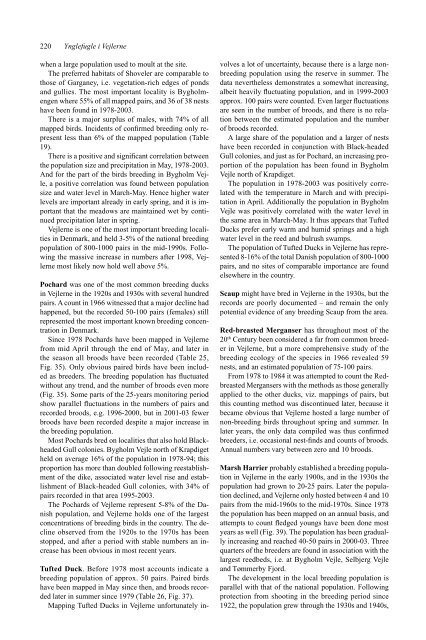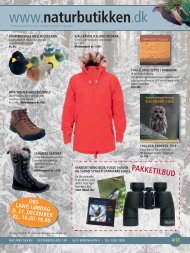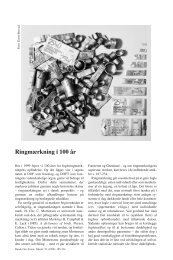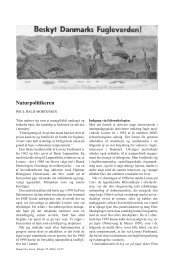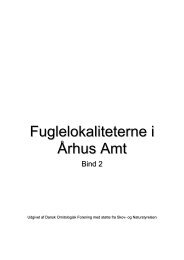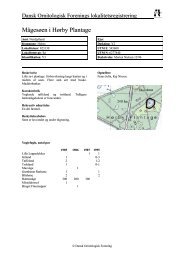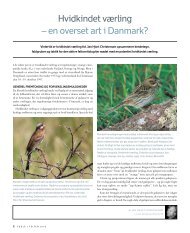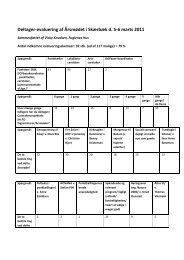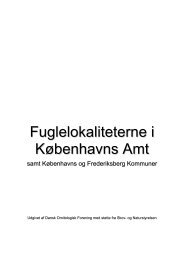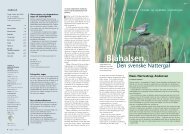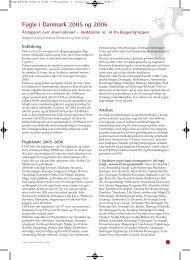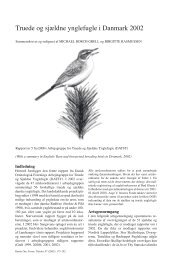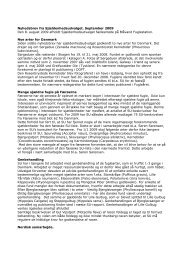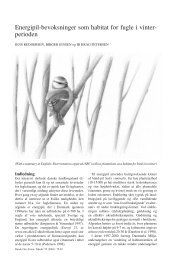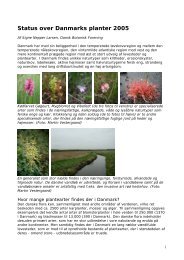Ynglefugle i Vejlerne - Dansk Ornitologisk Forening
Ynglefugle i Vejlerne - Dansk Ornitologisk Forening
Ynglefugle i Vejlerne - Dansk Ornitologisk Forening
You also want an ePaper? Increase the reach of your titles
YUMPU automatically turns print PDFs into web optimized ePapers that Google loves.
220 <strong>Ynglefugle</strong> i <strong>Vejlerne</strong><br />
when a large population used to moult at the site.<br />
The preferred habitats of Shoveler are comparable to<br />
those of Garganey, i.e. vegetation-rich edges of ponds<br />
and gullies. The most important locality is Bygholmengen<br />
where 55% of all mapped pairs, and 36 of 38 nests<br />
have been found in 1978-2003.<br />
There is a major surplus of males, with 74% of all<br />
mapped birds. Incidents of conrmed breeding only represent<br />
less than 6% of the mapped population (Table<br />
19).<br />
There is a positive and signicant correlation between<br />
the population size and precipitation in May, 1978-2003.<br />
And for the part of the birds breeding in Bygholm Vejle,<br />
a positive correlation was found between population<br />
size and water level in March-May. Hence higher water<br />
levels are important already in early spring, and it is important<br />
that the meadows are maintained wet by continued<br />
precipitation later in spring.<br />
<strong>Vejlerne</strong> is one of the most important breeding localities<br />
in Denmark, and held 3-5% of the national breeding<br />
population of 800-1000 pairs in the mid-1990s. Following<br />
the massive increase in numbers after 1998, <strong>Vejlerne</strong><br />
most likely now hold well above 5%.<br />
Pochard was one of the most common breeding ducks<br />
in <strong>Vejlerne</strong> in the 1920s and 1930s with several hundred<br />
pairs. A count in 1966 witnessed that a major decline had<br />
happened, but the recorded 50-100 pairs (females) still<br />
represented the most important known breeding concentration<br />
in Denmark.<br />
Since 1978 Pochards have been mapped in <strong>Vejlerne</strong><br />
from mid April through the end of May, and later in<br />
the season all broods have been recorded (Table 25,<br />
Fig. 35). Only obvious paired birds have been included<br />
as breeders. The breeding population has uctuated<br />
without any trend, and the number of broods even more<br />
(Fig. 35). Some parts of the 25-years monitoring period<br />
show parallel uctuations in the numbers of pairs and<br />
recorded broods, e.g. 1996-2000, but in 2001-03 fewer<br />
broods have been recorded despite a major increase in<br />
the breeding population.<br />
Most Pochards bred on localities that also hold Blackheaded<br />
Gull colonies. Bygholm Vejle north of Krapdiget<br />
held on average 16% of the population in 1978-94; this<br />
proportion has more than doubled following reestablishment<br />
of the dike, associated water level rise and establishment<br />
of Black-headed Gull colonies, with 34% of<br />
pairs recorded in that area 1995-2003.<br />
The Pochards of <strong>Vejlerne</strong> represent 5-8% of the Danish<br />
population, and <strong>Vejlerne</strong> holds one of the largest<br />
con centrations of breeding birds in the country. The decline<br />
observed from the 1920s to the 1970s has been<br />
stopped, and after a period with stable numbers an increase<br />
has been obvious in most recent years.<br />
Tufted Duck. Before 1978 most accounts indicate a<br />
breeding population of approx. 50 pairs. Paired birds<br />
have been mapped in May since then, and broods recorded<br />
later in summer since 1979 (Table 26, Fig. 37).<br />
Mapping Tufted Ducks in <strong>Vejlerne</strong> unfortunately in-<br />
volves a lot of uncertainty, because there is a large nonbreeding<br />
population using the reserve in summer. The<br />
data nevertheless demonstrates a somewhat increasing,<br />
albeit heavily uctuating population, and in 1999-2003<br />
approx. 100 pairs were counted. Even larger uctuations<br />
are seen in the number of broods, and there is no relation<br />
between the estimated population and the number<br />
of broods recorded.<br />
A large share of the population and a larger of nests<br />
have been recorded in conjunction with Black-headed<br />
Gull colonies, and just as for Pochard, an increasing proportion<br />
of the population has been found in Bygholm<br />
Vejle north of Krapdiget.<br />
The population in 1978-2003 was positively correlated<br />
with the temperature in March and with precipitation<br />
in April. Additionally the population in Bygholm<br />
Vejle was positively correlated with the water level in<br />
the same area in March-May. It thus appears that Tufted<br />
Ducks prefer early warm and humid springs and a high<br />
water level in the reed and bulrush swamps.<br />
The population of Tufted Ducks in <strong>Vejlerne</strong> has represented<br />
8-16% of the total Danish population of 800-1000<br />
pairs, and no sites of comparable importance are found<br />
elsewhere in the country.<br />
Scaup might have bred in <strong>Vejlerne</strong> in the 1930s, but the<br />
records are poorly documented – and remain the only<br />
potential evidence of any breeding Scaup from the area.<br />
Red-breasted Merganser has throughout most of the<br />
20 th Century been considered a far from common breeder<br />
in <strong>Vejlerne</strong>, but a more comprehensive study of the<br />
breeding ecology of the species in 1966 revealed 59<br />
nests, and an estimated population of 75-100 pairs.<br />
From 1978 to 1984 it was attempted to count the Redbreasted<br />
Mergansers with the methods as those gene rally<br />
applied to the other ducks, viz. mappings of pairs, but<br />
this counting method was discontinued later, because it<br />
be came obvious that <strong>Vejlerne</strong> hosted a large number of<br />
non-breeding birds throughout spring and summer. In<br />
later years, the only data compiled was thus conrmed<br />
bree ders, i.e. occasional nest-nds and counts of broods.<br />
Annual numbers vary between zero and 10 broods.<br />
Marsh Harrier probably established a breeding population<br />
in <strong>Vejlerne</strong> in the early 1900s, and in the 1930s the<br />
population had grown to 20-25 pairs. Later the population<br />
declined, and <strong>Vejlerne</strong> only hosted between 4 and 10<br />
pairs from the mid-1960s to the mid-1970s. Since 1978<br />
the population has been mapped on an annual basis, and<br />
attempts to count edged youngs have been done most<br />
years as well (Fig. 39). The population has been gradually<br />
increasing and reached 40-50 pairs in 2000-03. Three<br />
quarters of the breeders are found in association with the<br />
largest reedbeds, i.e. at Bygholm Vejle, Selbjerg Vejle<br />
and Tømmerby Fjord.<br />
The development in the local breeding population is<br />
parallel with that of the national population. Following<br />
protection from shooting in the breeding period since<br />
1922, the population grew through the 1930s and 1940s,


